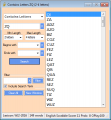| « Tax-Aide Repents on Education Credits: I Win! | Education Tax Credits: And Other Educational Incentives » |
Educational Components of H. R. 2029
In mid-December Congress passed the 2016 Consolidated Appropriations Act, including amendments titled Protecting Americans from Tax Hikes (PATH) H.R. 2029. That bill addressed a wide array of concerns but it may be best known as the tax extender bill.
AOTC Permanence
Those interested in education credits welcomed the extender package because it made the American Opportunity Tax Credit (AOTC) permanent. Unlike many AOTC proposals made during the year that would rewrite the AOTC, unfortunately this package only makes AOTC permanent by removing the phrase "and before 2018" in IRC Section 25A(i). The amounts are the same, with no inflation adjustment; the phase-out is the same; and the qualifications are essentially the same. Although the act does not rewrite AOTC, the permanence provision is not the only change in the education benefits.
AOTC Due Diligence
The new law will add due diligence requirements to the AOTC. The law requires the Treasury department to study the credit requirements and define what needs to be added to the regulations and forms to verify due diligence (IRC Section 6695(g)). It will be effective for tax years after Dec 31, 2015. Due diligence requirements previously applied to paid tax preparers filing claims for the Earned Income Tax Credit (EITC). The change adds requirements to AOTC as well as the Child Tax Credit, along with the $500 penalty.
AOTC Disallowance Consequences
Another change that appears to address the issue of AOTC fraud is the disallowance of claims for a period of 2 years for reckless disregard, and 10 years for fraud in filing education credit claims (IRC Section 25A(i)(7). There are allowances for math or clerical errors. There is also a continuing disallowance for deficency error until the error is resolved on any prior year claim.
Prevention of Retroactive Claims
Although rarely an issue, the bill also prevents retroactive claims for AOTC for any year the taxpayer does not have an ITIN. The individual’s taxpayer identification number must have been issued on or before the due date for filing the return of tax for the taxable year. This is effective on enactment, but there is an exception for 2015 so that the law does not apply to returns (not amendments) that are filed by the due date.
In the bill, this restriction follows a section that restricts EITC claims. The new law prevents taxpayers from amending returns after the taxpayer receives a social security number to claim EITC for years with an ITIN. AOTC doesn't require a social security number, but it does require a taxpayer identification number. It had been discussed that changes in the law should disallow the credit to anyone with an ITIN but that is not in this bill.
Reporting Requirements
Two reporting requirements have been changed with this bill. The first requirement is that taxpayers claiming the "Hope Scholarship Credit" must include the employer identification number of the institution (IRC Section 25A(i)(6)(C)). Additionally, institutions are now explicitly required to include their EIN on the statement (new IRC Section 6050S(b)(2)(C)). This may be moot, since IRC Section 25A(g)(8) requires taxpayers to have a payee statement to claim the credit and the institution normally provides that. This is just another effort to crackdown on suspected education credit fraud.
The second requirement simplifies reporting requirements of the institution. In the future, institutions must report amounts paid in the tax year (IRC Section 6050S(b)(2)(B)(i)). They can no longer report amounts billed. This provision is effective for expenses paid after Dec. 31, 2015.
Section 529 Changes
Other items that may be generating cheers from parents are modiications to Section 529. Beginning with the current tax year, the new law expands the definition of Section 529 qualified higher education expenses to include computer technology and equipment.
During 2009 and 2010, there was an allowance for computer equipment, but it was never extended. The new allowance includes ‘‘(iii) expenses for the purchase of computer or peripheral equipment (as defined in section 168(i)(2)(B)), computer software (as defined in section 197(e)(3)(B)), or Internet access and related services, if such equipment, software, or services are to be used primarily by the
beneficiary during any of the years the beneficiary is enrolled at an eligible educational institution’’ (IRC Section 529(e)(3)(A)(iii)).
Since the subsection applies to tax year 2015, if you did purchase a computer, it qualifies as an expense. It's unsure if you can now go out and buy a computer for Christmas, and claim it as an expense for this year, since most colleges are out for the holiday break. If you purchase it this year and use it next year (any year), it appears to qualify.
Also related to Section 529, account rules have been changed to eliminate the distribution aggregation requirements, so any distribution from a 529 account will be treated as coming only from that account, even if the individual making the distribution has more than one 529 account (IRC Section 529(c)(3)(D) removed). This allow taxpayers to select the account with the most, or least, amount of earnings. Again, the change is effective for 2015 distributions.
Section 529 account owners can now avoid penalties due to tuition refunds. The new law treats a refund of tuition that was paid with amounts distributed from a 529 account as a qualified expense if the amount is recontributed to a 529 account within 60 days of the date of the refund (New IRC Section 529(c)(3)(D) added). An exception to the 60 day rule applies to 2015 refunds such that taxpayers have 60 days after the date of enactment. Since the qualification date refers to the refund not the distribution, it appears that if you took a distribution in September of 2014 which was refunded on January 2, 2015 you still have until February 17, 2016 to recontribute the funds.
Work-Learning-Service Programs
Finally, the new law exempts taxpayers from including income from certain work-learning-service programs operated by "work colleges" as defined by the Higher Education Act of 1965. This exemption begins in tax year 2015. If you are like me and wonder what that is, refer to 42 USC § 2756b and 34 CFR Part 675. Work colleges include a handful of institutions that require at least half of all students to work as a part of their academic experience. This exception adds to a few other exceptions provided by IRC Section 117(c)(2).
Book Updates
Two months after I published my first book, Education Tax Credit Essentials, Congress passed a law that limits education credits for taxpayers with a payee statement. Then less that two months after I published the updated and expanded Education Tax Credits And Other Educational Incentives, Congress passed another law that makes the AOTC permanent, enhanced Section 529 spending, and added other restrictions to the AOTC. Revisions of the two texts are in process, and I don't expert there will not be any additional congressional action on educational incentives for another year. There is an issue that does need to be addressed before next filing season. Although taxpayers will then be required to have a payee statement to claim the AOTC, institutions are not always required to provide it. This discrepancy could deprive many taxpayers of the credit. See the post Education Credit Alert, and a more detailed discussion in my book Education Tax Credits.

